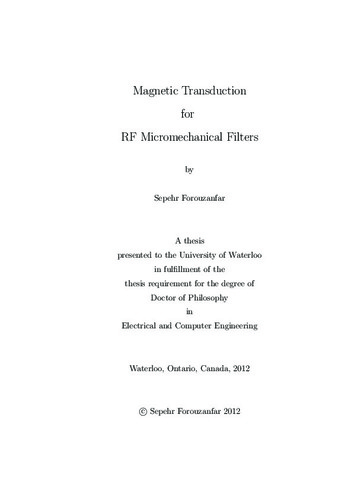| dc.description.abstract | The use of electrostatic transduction has enabled high-Q miniaturized mechanical
resonators made of non-piezoelectric material that vibrate at high and ultra high
frequencies. However, this transduction technique suffers from large values of motional resistance associated with the technique, limiting its use for interfacing to
standard 50
RF circuits. Piezoelectric transduction has advantages over the electrostatic method because of its comparable to 50
motional resistance. However,
the technique requires use of thin film piezoelectric materials with the demonstrated
Qs that are much lower than their corresponding non-piezoelectric resonators. This
research proposes use of electrodynamic transduction, reports analytic and experimental studies on electrodynamic transduction for RF application, highlights the
method’s advantages, and lists the contributions.
The use of Lorentz-force transduction for RF micromechanical filters proposed
in this work is pursued by experimentally evaluating the transduction technique
implemented for microfabricated designs. By fabricating single and coupled microresonators in a few different fabrication technologies, including CMOS35, the
performance of the Lorentz-force driven microresonators is studied. Using a laser
vibrometer, the actual performance, including the displacement and velocity of the
moving points of the microstructures’ surfaces, are measured.
The mode shapes and resonance specifications of the microstructures in air and
vacuum derived by laser vibrometer provide data for characterizing the employed
Lorentz-force transduction technique. Furthermore, the results from the electrical
measurements are compared to the micromechanical resonators’ frequency response
obtained from the mechanical measurements by laser vibrometer. The significantly
low values of motional resistance computed for the differently fabricated designs
demonstrate the advantage of Lorentz-force transduction for RF filter applications.
Should a device similar in size be driven electrostatically, the motional resistance
would be multiple orders of magnitude higher.
This research reports the experimental results obtained by examining a Lorentz-
force transduction application for developing RF micromechanical filters. The results demonstrate the Lorentz-force transduction’s advantages over other transduction methods used for RF μ-mechanical filters. Compared to electrostatic transduction, the Lorentz-force method provides greater electromechanical coupling, multiple orders of magnitude lower motional resistance, the independence of the filter
center frequency from the bias voltage, higher power handling, and no requirement
for bias lines, which decreases the work in microfabrication. Unlike piezoelectric
transduction, the electrodynamic technique requires no piezoelectric material. Use
of non-piezoelectric materials provides more flexibility for resonator material in
the IC-compatible fabrications. Power handling in electrodynamic transduction
has fewer limitations than other transduction techniques because the higher power
needed in electrostatic or piezoelectric methods requires a higher voltage, which
is limited by the breakdown voltage. The higher power in Lorentz-force-based
transduction demands a larger current. The larger current produces heat that is
removable by applying an appropriate cooling technique. | en |

